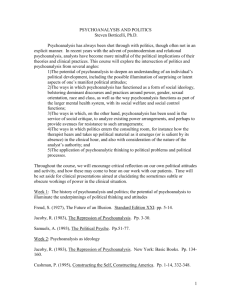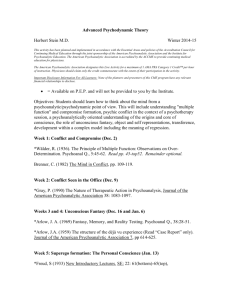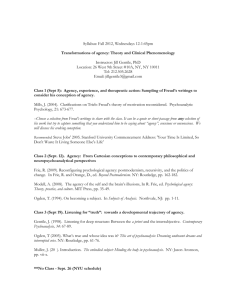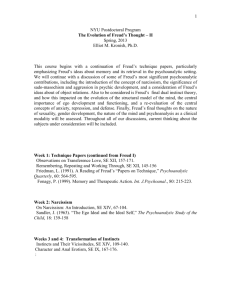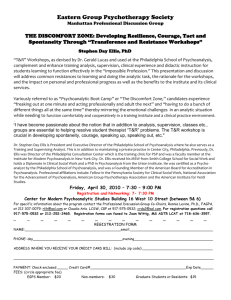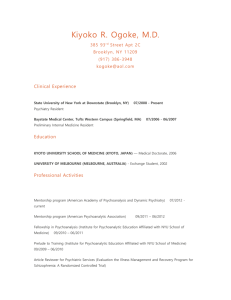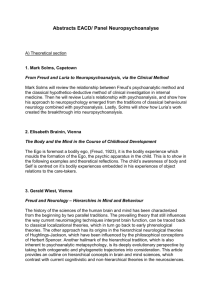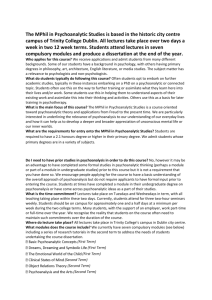psychoanalysis and cultural studies
advertisement
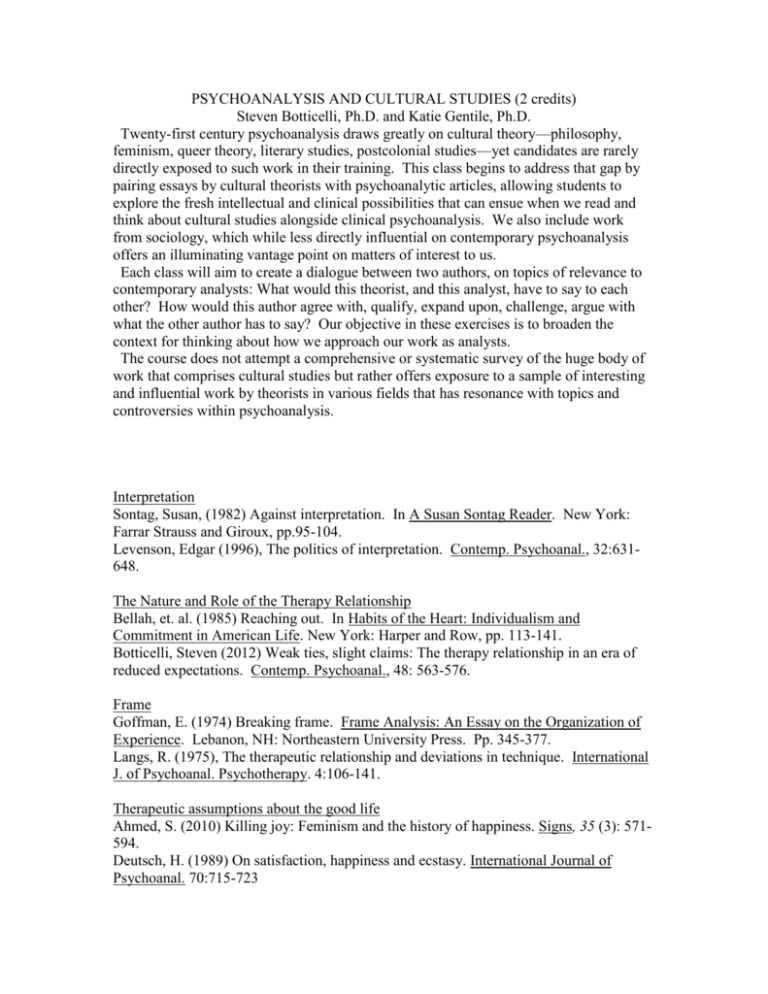
PSYCHOANALYSIS AND CULTURAL STUDIES (2 credits) Steven Botticelli, Ph.D. and Katie Gentile, Ph.D. Twenty-first century psychoanalysis draws greatly on cultural theory—philosophy, feminism, queer theory, literary studies, postcolonial studies—yet candidates are rarely directly exposed to such work in their training. This class begins to address that gap by pairing essays by cultural theorists with psychoanalytic articles, allowing students to explore the fresh intellectual and clinical possibilities that can ensue when we read and think about cultural studies alongside clinical psychoanalysis. We also include work from sociology, which while less directly influential on contemporary psychoanalysis offers an illuminating vantage point on matters of interest to us. Each class will aim to create a dialogue between two authors, on topics of relevance to contemporary analysts: What would this theorist, and this analyst, have to say to each other? How would this author agree with, qualify, expand upon, challenge, argue with what the other author has to say? Our objective in these exercises is to broaden the context for thinking about how we approach our work as analysts. The course does not attempt a comprehensive or systematic survey of the huge body of work that comprises cultural studies but rather offers exposure to a sample of interesting and influential work by theorists in various fields that has resonance with topics and controversies within psychoanalysis. Interpretation Sontag, Susan, (1982) Against interpretation. In A Susan Sontag Reader. New York: Farrar Strauss and Giroux, pp.95-104. Levenson, Edgar (1996), The politics of interpretation. Contemp. Psychoanal., 32:631648. The Nature and Role of the Therapy Relationship Bellah, et. al. (1985) Reaching out. In Habits of the Heart: Individualism and Commitment in American Life. New York: Harper and Row, pp. 113-141. Botticelli, Steven (2012) Weak ties, slight claims: The therapy relationship in an era of reduced expectations. Contemp. Psychoanal., 48: 563-576. Frame Goffman, E. (1974) Breaking frame. Frame Analysis: An Essay on the Organization of Experience. Lebanon, NH: Northeastern University Press. Pp. 345-377. Langs, R. (1975), The therapeutic relationship and deviations in technique. International J. of Psychoanal. Psychotherapy. 4:106-141. Therapeutic assumptions about the good life Ahmed, S. (2010) Killing joy: Feminism and the history of happiness. Signs, 35 (3): 571594. Deutsch, H. (1989) On satisfaction, happiness and ecstasy. International Journal of Psychoanal. 70:715-723 Regarding the Other Said, Edward (1978) Introduction. In Orientalism. NY: Vintage, pp. 1-30. Suchet, Melanie (2010) Face to face. Psychoanal. Dial., 20: 158-171. Witnessing as Othering Cornell, D. (2010). The ethical affirmation of human rights: Gayatri Spivak’s intervention. In R. C. Morris (Ed.) Reflections on the history of an idea: Can the subaltern speak? New York: Columbia University Press. Pp. 100-114. Gentile, K. (2013). Bearing the cultural to engage in a process of witnessing. Psychoanalytic Psychotherapy. Sexuality Foucault, Michel (1976) The repressive hypothesis. In The History of Sexuality Vol. 1. New York: Vintage, pp. 15-49. Davies, J. (2004), Love in the afternoon: A relational reconsideration of desire and dread in the countertransference. Psychoanal. Dial., 4: 153-170. Power/Authority Foucault, Michel (1961), The birth of the asylum. In Madness and Civilization: A History of Insanity in the Age of Reason. New York: Vintage. Pp. 241-278. Hoffman, Irwin, (1996), The intimate and ironic authority of the psychoanalyst’s presence. Psychoanal. Quarterly, 65: 102-136. Interpellation Althusser, Louis (1969) Ideology and ideological state apparatuses. In Lenin and Philosophy and Other Essays. NY: Monthly Review Press. Pp. 127-186. Corbett, Ken (2009) Faggot= loser: Phallic narcissism as a defense. In Boyhoods:Rethinking Masculinities. Pp. 173-207. Intersectionality Collins, P. H. (1990). Black feminist thought in the matrix of domination. In Black feminist thought: Knowledge, consciousness and the politics of empowerment, pp. 221238. New York: Routledge. Saketopoulou, A. (2011). Minding the gap: Intersections between gender, race, and class in work with gender variant children. Psychoanalytic Dialogues, Vol 21(2): 192-209. Loss/Trauma and Its Aftermath Love, Heather (2007), Introduction. In Feeling Backward: Loss and the Politics of Queer History. Cambridge, MA: Harvard University Press. pp. 1-30. Gerson, Samuel (2009), When the third is dead: Memory, mourning and witnessing in the aftermath of the Holocaust. International J. of Psychoanal., 90: 1341-1357. Gender Butler, J. (1990), Gender Trouble. New York: Routledge. Pp.vii-xii, 128-149. Goldner, V. (1991) Toward a critical relational theory of gender. Psychoanal. Dial., 1: 249-272. Integrating neuroscience Pitts-Taylor, V. (2010). The plastic brain: Neoliberalism and the neuronal self. Health: An interdisciplinary journal for the social study of health, illness, and medicine, 14 (6): 635-652. Koehler, B. (2011). Psychoanalysis and neuroscience in dialogue: Commentary on paper by Arnold H. Modell. Psychoanalytic Dialogues, 21 (3): 303-319. Changing Bhabha, H. (1994). How newness enters the world: Postmodern space, postcolonial times and the trials of cultural translation. In The Location of Culture, London: Routledge. Pp. 212-235. Bromberg, P. (1998), Staying the same while changing: Reflections on clinical judgment. Psychoanal. Dial., 8: 225-236. Bodies Baudrillard , J. (2005). The finest consumer object: The body. In M. Fraser & M. Greco (eds.), The Body: A Reader. New York: Routledge. Pp. 277-282. Knoblauch, S. (1996). The play and interplay of passionate experience: Multiple organizations of desire. Gender & Psychoanalysis, 1(3): 323-344.
